|
Dawn Launch, Bay of Oysters. . .
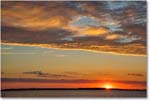 Island
time turns out to be the opposite of what your first impression might
be. One would suppose that while on vacation one would sleep in
and rise late in the morning. After all, why visit what for us is
"the island at
the end of the road" unless one wants to relax? But, if one has a
vacation house situated on the edge of a bay, Oyster Bay in this case,
with the sun streaming in through a floor-to-ceiling window-door each
morning, one can't help but be inspired to rise early to witness some
those spectacular sunrises. And if one has brought a kayak, so
much the better. Island
time turns out to be the opposite of what your first impression might
be. One would suppose that while on vacation one would sleep in
and rise late in the morning. After all, why visit what for us is
"the island at
the end of the road" unless one wants to relax? But, if one has a
vacation house situated on the edge of a bay, Oyster Bay in this case,
with the sun streaming in through a floor-to-ceiling window-door each
morning, one can't help but be inspired to rise early to witness some
those spectacular sunrises. And if one has brought a kayak, so
much the better.
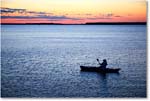 Our
family has branched out to become an ocean-going one -- well, at least a
Bay-going one. Kayaking was an every day event for the younger set
this year, and Oyster Bay is almost ideal for this most relaxing water
sport. Situated between Chincoteague and Assateague, the bay is
only a couple of feet deep for most of it's extent. And, small
Morris Island sits between the two larger islands, a good place to
circumnavigate on an outing. There, one catches sight of shorebirds
plying their trade. Oystercatchers do their thing, and marbled
godwits hide from otherwise prying eyes. Ponies may occasionally
be seen on the distant Assateague shore. And, through it all, the
hustle and bustle of urban life seems remote and unimportant. Our
family has branched out to become an ocean-going one -- well, at least a
Bay-going one. Kayaking was an every day event for the younger set
this year, and Oyster Bay is almost ideal for this most relaxing water
sport. Situated between Chincoteague and Assateague, the bay is
only a couple of feet deep for most of it's extent. And, small
Morris Island sits between the two larger islands, a good place to
circumnavigate on an outing. There, one catches sight of shorebirds
plying their trade. Oystercatchers do their thing, and marbled
godwits hide from otherwise prying eyes. Ponies may occasionally
be seen on the distant Assateague shore. And, through it all, the
hustle and bustle of urban life seems remote and unimportant.
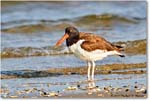 Of course, there are other reasons to rise early. Nature
photography at the
Chincoteague National Wildlife Refuge has, for years, been at its
best early in the morning. Birds of all types are out early,
getting breakfast in a variety of locations. It turns out that, as
the years have gone by, the best places have come to be near the beach.
The channels along the beach road still see activity, but it is a rare
circumstance when good, clean backgrounds are available. This
makes the reverse shoreline overlooking Tom's Cove an almost ideal
location. Not only is it isolated but the morning sun is directly
behind the photographer, making for good lighting through out the golden
light of the early morning sun. Of course, there are other reasons to rise early. Nature
photography at the
Chincoteague National Wildlife Refuge has, for years, been at its
best early in the morning. Birds of all types are out early,
getting breakfast in a variety of locations. It turns out that, as
the years have gone by, the best places have come to be near the beach.
The channels along the beach road still see activity, but it is a rare
circumstance when good, clean backgrounds are available. This
makes the reverse shoreline overlooking Tom's Cove an almost ideal
location. Not only is it isolated but the morning sun is directly
behind the photographer, making for good lighting through out the golden
light of the early morning sun.
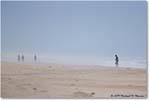 However,
things change later in the day. The beach starts to load up with
sunbathers and ocean surf lovers, creating crowds that drive birds and
other wildlife to distant locations. And the Wildlife Loop is
hardly worth the trouble to traverse. This visit, only one trip
was made, and there was nothing worth stopping for. In past years,
the entire impoundment pond inside the Loop, the Snow Goose Pool, was filled with water -- and
thus with birds of every type. Now, the area is virtually
overgrown with vegetation, and the only remaining water pools are far
off the road -- any birds present are mere specs on the horizon. However,
things change later in the day. The beach starts to load up with
sunbathers and ocean surf lovers, creating crowds that drive birds and
other wildlife to distant locations. And the Wildlife Loop is
hardly worth the trouble to traverse. This visit, only one trip
was made, and there was nothing worth stopping for. In past years,
the entire impoundment pond inside the Loop, the Snow Goose Pool, was filled with water -- and
thus with birds of every type. Now, the area is virtually
overgrown with vegetation, and the only remaining water pools are far
off the road -- any birds present are mere specs on the horizon.
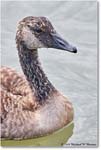 In
part, the Snow Goose Pool situation is due to active Refuge management,
although the benefit comes in the fall and winter, unfortunate timing
for summer photographers. The water is periodically pumped out,
and the whole pool is plowed up to prevent the growth of invasive
vegetation that would forestall water bird feeding favorites. From
the Refuge web site: In
part, the Snow Goose Pool situation is due to active Refuge management,
although the benefit comes in the fall and winter, unfortunate timing
for summer photographers. The water is periodically pumped out,
and the whole pool is plowed up to prevent the growth of invasive
vegetation that would forestall water bird feeding favorites. From
the Refuge web site:
We are currently pumping water from the Snow Goose Pool into the
Black Duck Pool in order to lower water levels and dry the soil.
This management action is needed in order to use farm tractors to
mow and disk the bottom of the impoundment. By setting back
succession and turning over the soil, we provide excellent foraging
habitat for migratory shorebirds that eat invertebrates in the soil.
Furthermore, it will encourage the growth of native plants that
serve as waterfowl food in the fall and winter. A certain amount of
woody vegetation is kept around the edges of the impoundments to
provide windbreaks and shelter for other wildlife - though we try to
keep it open enough for viewing opportunities.
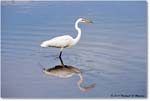 Nevertheless,
one
has to be a bit disappointed with the decrease in the bird population over the years. When we first began visiting the Refuge in 1990,
there were all-day feeding frenzies in Swan Cove, the large impoundment
across the road from Little Tom's Cove. Mornings saw every type of bird on
the island silhouetted against the dawn sky, rendered in beautiful
mauves and pinks and oranges. Nevertheless,
one
has to be a bit disappointed with the decrease in the bird population over the years. When we first began visiting the Refuge in 1990,
there were all-day feeding frenzies in Swan Cove, the large impoundment
across the road from Little Tom's Cove. Mornings saw every type of bird on
the island silhouetted against the dawn sky, rendered in beautiful
mauves and pinks and oranges.
And the afternoon sun illuminated
great and snowy egrets and great blue herons fishing in clear
water reflecting the deep blue summer sky. Now, Swan Cove is covered with
pond scum and only an occasional gull or duck bothers to
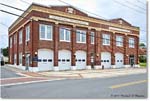 forage there. forage there.
Nevertheless,
we did manage to keep busy photographically, and there are other things
to do and places to go once the sun got high in the sky. Besides
the usual shopping, there were visits by Canada Goose families, come to see
what all the excitement at our dock was all about. And, a visit
downtown with camera in hand produced a
photo record of the historic
fishing village Main Street, including the classic old fire station. There has been much change in the intervening
three decades since our first visit, but at its heart, Chincoteague is
still very much a small and delightful
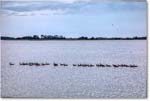 refuge
from the frenetic pace of modern life. refuge
from the frenetic pace of modern life.
One of the most
pleasant surprises was the high quality of the ever-improving
Museum of
Chincoteague. Once two separate, smaller organizations, the
merged museum has been upgraded over the years, and it now features an
extensive collection of artifacts from the history of life on
Chincoteague and Assateague islands. There's even a decoy carver's
museum next door, and a working one at that, complete with scheduled
carving
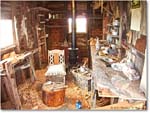 demonstrations. And, for the kids (and adults as well) the
museum provides a sheet of things to look for during one's visit.
It's a sort of scavenger hunt, a list of items hidden in plain sight
among the artifacts. Can you find everything on the list? We
couldn't, and both of us tried! demonstrations. And, for the kids (and adults as well) the
museum provides a sheet of things to look for during one's visit.
It's a sort of scavenger hunt, a list of items hidden in plain sight
among the artifacts. Can you find everything on the list? We
couldn't, and both of us tried!
In any case, life on island time is about as
relaxing as it gets, and we always look forward to our next visit.
|


 In
part, the Snow Goose Pool situation is due to active Refuge management,
although the benefit comes in the fall and winter, unfortunate timing
for summer photographers. The water is periodically pumped out,
and the whole pool is plowed up to prevent the growth of invasive
vegetation that would forestall water bird feeding favorites. From
the Refuge web site:
In
part, the Snow Goose Pool situation is due to active Refuge management,
although the benefit comes in the fall and winter, unfortunate timing
for summer photographers. The water is periodically pumped out,
and the whole pool is plowed up to prevent the growth of invasive
vegetation that would forestall water bird feeding favorites. From
the Refuge web site:
